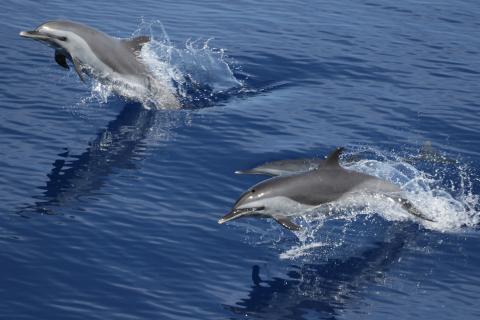Setting sail from Mississippi in June into the Gulf of Mexico, a team of scientists are scanning the horizon with their “big eyes” binoculars for the next several months, on the lookout for birds and marine mammals that can best be seen from sea.
Covering thousands of miles on two surveys between June 22 and August 17, the team will gather hard-to-collect data on the populations of seabirds and marine mammals in the Gulf that were impacted by the 2010 Deepwater Horizon oil spill. The U.S. Fish and Wildlife Service and NOAA’s Southeast Fisheries Science Center are conducting these surveys using $2.3 million in BP settlement funds approved by the Deepwater Horizon Open Ocean Trustees.
The survey project will address critical data gaps that allow for more informed planning, implementation and evaluation of restoration efforts for seabirds and marine mammals. In particular, data will be used to update habitat models, distribution maps, and estimates of numbers of animals. This information will provide insights into how abundance and distribution of seabirds and marine mammals may change over time in response to changes in the environment.
Two observer teams will conduct visual surveys, one team for marine mammals and another for seabirds. The marine mammal observers will spend most of their time looking through “big eyes”—giant binoculars—searching for animals. Once they spot a marine mammal, they will identify the species, determine the group size, and take photos.
An acoustic team will also be listening for and recording marine mammal vocalizations using a towed array of hydrophones to augment the visual observations.
The seabird observers have the important and challenging goal of gathering data about the distribution and abundance of offshore seabird species, including shearwaters, storm-petrels and boobies. Of the top 20 bird species injured by the spill, 15 were seabirds; these species account for 80 percent of the total injury to birds. Vessel-based surveys are a critical source of data for the injured seabird species that are found in the open waters of the Gulf of Mexico.
Additional Resources
-
Open Ocean Trustees Release Plan for At-Sea Surveys of Gulf Seabirds and Marine Mammals (August 2022)
-
Vessel Surveys for Abundance and Distribution of Marine Mammals and Seabirds (PDF, 20 pages)
-
Project Blog Series (Southeast Fisheries Science Center)
We also send updates out via email. If you haven't already, please take the opportunity to sign up for email updates today to receive the latest news from all the Deepwater Horizon Trustees.


